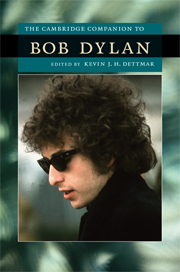Book contents
- Frontmatter
- Introduction
- Part I Perspectives
- 1 Bob Dylan and the Anglo-American tradition
- 2 Bob Dylan and Rolling Thunder
- 3 Bob Dylan as songwriter
- 4 Bob Dylan as performer
- 5 Bob Dylan and collaboration
- 6 Bob Dylan and gender politics
- 7 Bob Dylan and religion
- 8 Bob Dylan and the Academy
- 9 Bob Dylan as cultural icon
- Part II Landmark Albums
- Works cited
- Index
4 - Bob Dylan as performer
from Part I - Perspectives
Published online by Cambridge University Press: 28 May 2009
- Frontmatter
- Introduction
- Part I Perspectives
- 1 Bob Dylan and the Anglo-American tradition
- 2 Bob Dylan and Rolling Thunder
- 3 Bob Dylan as songwriter
- 4 Bob Dylan as performer
- 5 Bob Dylan and collaboration
- 6 Bob Dylan and gender politics
- 7 Bob Dylan and religion
- 8 Bob Dylan and the Academy
- 9 Bob Dylan as cultural icon
- Part II Landmark Albums
- Works cited
- Index
Summary
In December of 1965, Bob Dylan gave a press conference in San Francisco. It was a prime example of his hyperspeed, evasive jousting with the media at the time. “How do you explain your attraction?” he was asked at one point in this curious televised event, to which he responded, “Attraction to what?” But Dylan, then 25 years old and in the midst of the historic concert tour that found him getting booed around the world for playing with an amplified rock band, gave a serious answer when someone inquired about whether he preferred playing live or making records. “Concerts are much more fun than they used to be,” he said, “[but] the albums are the most important. It's all concrete, it's very concise, and it's easy to hear the words and everything” (Dylan Speaks). Several months later, frayed and ravaged from the tour (and from the requirements and expectations involved in being Bob Dylan), the singer wrecked his motorcycle in Woodstock, New York, and while the severity of his injuries has never been verified, it provided him with the necessary justification for getting off the road. It would be eight years until he went back on tour - and so, at the peak of his popularity and influence, it seemed certain that Bob Dylan would be defined almost entirely as a recording artist. Forty years later, though, things didn't work out that way. After an ambivalent and erratic approach to live performance in the 1970s and '80s, Dylan embraced the touring life whole-heartedly, connecting himself directly back to the troubadour tradition from which he sprang. Since beginning the journey often referred to as the Never Ending Tour in 1988, he has played over a hundred shows a year, every year: he has now passed the 2,000-concert mark during this era. Dylan sightings were once as rare as those of the Loch Ness Monster. Now, he can be found on stage at state fairs, corporate functions - anywhere with an audience is apparently fine by him.
- Type
- Chapter
- Information
- The Cambridge Companion to Bob Dylan , pp. 55 - 68Publisher: Cambridge University PressPrint publication year: 2009



